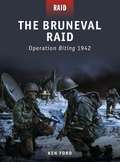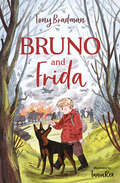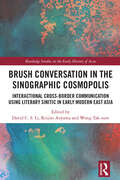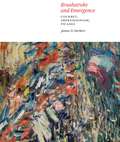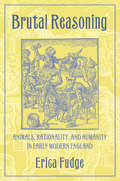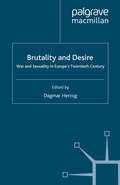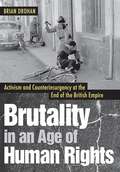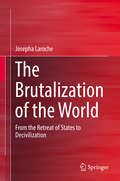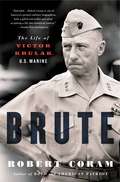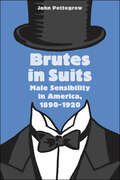- Table View
- List View
Brunelleschi's Dome: How a Renaissance Genius Reinvented Architecture
by Ross KingOn August 19, 1418, a competition concerning Florence's magnificent new cathedral, Santa Maria del Fiore--already under construction for more than a century--was announced: "Whoever desires to make any model or design for the vaulting of the main Dome....shall do so before the end of the month of September." The proposed dome was regarded far and wide as all but impossible to build: not only would it be enormous, but its original and sacrosanct design shunned the flying buttresses that supported cathedrals all over Europe. The dome would literally need to be erected over thin air. Of the many plans submitted, one stood out--a daring and unorthodox solution to vaulting what is still the largest dome (143 feet in diameter) in the world. It was offered not by a master mason or carpenter, but by a goldsmith and clockmaker named Filippo Brunelleschi, who would dedicate the next twenty-eight years to solving the puzzles of the dome's construction. In the process, he did nothing less than reinvent the field of architecture. Brunelleschi's Dome is the story of how a Renaissance genius bent men, materials, and the very forces of nature to build an architectural wonder we continue to marvel at today. Denounced at first as a madman, Brunelleschi was celebrated at the end as a genius. He engineered the perfect placement of brick and stone, built ingenious hoists and cranes to carry an estimated 70 million pounds hundreds of feet into the air, and designed the workers' platforms and routines so carefully that only one man died during the decades of construction--all the while defying those who said the dome would surely collapse and his own personal obstacles that at times threatened to overwhelm him. Even today, in an age of soaring skyscrapers, the cathedral dome of Santa Maria del Fiore retains a rare power to astonish. Ross King brings its creation to life in a fifteenth-century chronicle with twenty-first-century resonance.
The Bruneval Raid: Operation Biting 1942 (Raid #13)
by Ken FordIn the darkest days of World War II, the British planned a daring airborne operation to capture the secret of the new German radar. Lead by Major John Frost, a company of paratroopers dropped into Bruneval on the French coast, and quickly neutralized a small German garrison. Then began a desperate fight for time as the British tried to dismantle the German radar and evacuate back to England, as ever more German units converged on their position. Using artwork, photographs, and detailed maps, this action-packed narrative puts the reader in the planning room and on the battlefield of one of the greatest raids of World War II.
The Bruneval Raid: Operation Biting 1942 (Raid)
by Howard Gerrard Ken Ford Alan GillilandIn the darkest days of World War II, the British planned a daring airborne operation to capture the secret of the new German radar. Lead by Major John Frost, a company of paratroopers dropped into Bruneval on the French coast, and quickly neutralized a small German garrison. Then began a desperate fight for time as the British tried to dismantle the German radar and evacuate back to England, as ever more German units converged on their position. Using artwork, photographs, and detailed maps, this action-packed narrative puts the reader in the planning room and on the battlefield of one of the greatest raids of World War II.
Bruno and Frida
by Tony BradmanFriendship forms in the midst of war between a young German boy and a Russian bomber-dog, in this poignant and gripping historical adventure.
Bruno Bauer and Karl Marx: The Influence of Bruno Bauer on Marx’s Thought (Studies in Social History #2)
by Z. RosenThe present work is aimed at filling a hiatus in the literature dealing with the Young Hegelians and the early thought of Karl Marx. Despite the prevalent view in the past few decades that Bruno Bauer played an important part in the radical activity of Hegel's young disciples in the eighteen forties in Germany, no comprehensive work has so far been published on the relations between Bauer and Marx. In 1927 Ernst Bar nikol promised to write a monograph on the subject, but he never did. For the purpose of this study I perused material in numerous library collections and I would like to express my gratitude to the staff of the following institutions: Tel Aviv University Library, the Library and Archive of the International Institute of Social History in Am sterdam, the Heidelberg University Library, the Library of Gottingen University, the Tiibingen University Library, Frankfurt University Library, the State Library at Marburg, the Manuscript Department of the State Archives in Berlin.
Brunswick Gardens: A thrilling journey into corruption and murder in Victorian London (Thomas Pitt Mystery #18)
by Anne PerryDoes the murder of a young woman have a religious cause? Anne Perry's Brunswick Gardens delves deep into the politics of the church, uncovering thwarted ambitions, unfulfilled promises and frustrated passions amid murder. Perfect for fans of C. J. Samson and Ann Granger.'Beautifully crafted, filled with the gaslit atmosphere of a bygone world' - Cosmopolitan In London's affluent Brunswick Gardens, the battle over Charles Darwin's revolutionary theory of evolution intensifies as the respected Reverend Parmenter is boldly challenged by his beautiful assistant, Unity Bellwood - a 'new woman' whose feminism and aggressive Darwinism he finds appalling. When Unity, three months pregnant, tumbles down a staircase to her death, Superintendent Thomas Pitt is certain that one of the three deeply devout men in the house committed murder. Could it have been the Reverend Parmenter? His handsome curate? Or his son, a fervent Roman Catholic? Pitt and his clever wife, Charlotte, will refuse to settle for less than the truth - or less than justice. What readers are saying about Anne Perry: '[Anne Perry's] books are always gripping and beautifully written''These are a great set of books. Pitt is a really likeable hero''Five stars'
Brush Conversation in the Sinographic Cosmopolis: Interactional Cross-border Communication using Literary Sinitic in Early Modern East Asia (Routledge Studies in the Early History of Asia)
by David C. S. Li Reijiro Aoyama Wong Tak-SumFor hundreds of years until the 1900s, in today’s China, Japan, North and South Korea, and Vietnam, literati of Classical Chinese or Literary Sinitic (wényán 文言) could communicate in writing interactively, despite not speaking each other’s languages. This book outlines the historical background of, and the material conditions that led to,widespread literacy development in premodern and early modern East Asia, where reading and writing for formal purposes was conducted in Literary Sinitic. To exemplify how ‘silent conversation’ or ‘brush-assisted conversation’ is possible through writing-mediated brushed interaction, synchronously face-to-face, this book presents contextualized examples from recurrent contexts involving (i) boat drifters; (ii) traveling literati; and (iii) diplo- matic envoys. Where profound knowledge of classical canons and literary works in Sinitic was a shared attribute of the brush-talkers concerned, their brush-talk would characteristically be intertwined with poetic improvisation. Being the first monograph in English to address this fascinating lingua-cultural practice and cross-border communication phenomenon, which was possibly sui generis in Sinographic East Asia, it will be of interest to students of not only East Asian languages and linguistics, history, international relations, and diplomacy, but also (historical) pragmatics, sociolinguistics, sociology of language, scripts and writing systems, and cultural and linguistic anthropology.
Brush Conversation in the Sinographic Cosmopolis: Interactional Cross-border Communication using Literary Sinitic in Early Modern East Asia (Routledge Studies in the Early History of Asia)
by David C. S. Li Reijiro Aoyama Tak-Sum WongFor hundreds of years until the 1900s, in today’s China, Japan, North and South Korea, and Vietnam, literati of Classical Chinese or Literary Sinitic (wényán 文言) could communicate in writing interactively, despite not speaking each other’s languages. This book outlines the historical background of, and the material conditions that led to,widespread literacy development in premodern and early modern East Asia, where reading and writing for formal purposes was conducted in Literary Sinitic. To exemplify how ‘silent conversation’ or ‘brush-assisted conversation’ is possible through writing-mediated brushed interaction, synchronously face-to-face, this book presents contextualized examples from recurrent contexts involving (i) boat drifters; (ii) traveling literati; and (iii) diplo- matic envoys. Where profound knowledge of classical canons and literary works in Sinitic was a shared attribute of the brush-talkers concerned, their brush-talk would characteristically be intertwined with poetic improvisation. Being the first monograph in English to address this fascinating lingua-cultural practice and cross-border communication phenomenon, which was possibly sui generis in Sinographic East Asia, it will be of interest to students of not only East Asian languages and linguistics, history, international relations, and diplomacy, but also (historical) pragmatics, sociolinguistics, sociology of language, scripts and writing systems, and cultural and linguistic anthropology.
Brushed By Scandal: Brushed By Scandal / Courting Miss Vallois (Mills And Boon Historical Ser.)
by Gail WhitikerWHAT WILL SHE RISK FOR LOVE?
Brushstroke and Emergence: Courbet, Impressionism, Picasso
by James D. HerbertNo pictorial device in nineteenth-century French painting more clearly represented the free-ranging self than the loose brushstroke. From the romantics through the impressionists and post-impressionists, the brushstroke bespoke autonomous artistic individuality and freedom from convention. Yet the question of how much we can credit to the individual brushstroke is complicated—and in Brushstroke and Emergence, James D. Herbert uses that question as a starting point for an extended essay that draws on philosophy of mind, the science of emergence, and art history. Brushstrokes, he reminds us, are as much creatures of habit and embodied experience as they are of intent. When they gather in great numbers they take on a life of their own, out of which emerge complexity and meaning. Analyzing ten paintings by Courbet, Manet, Cézanne, Monet, Seurat, and Picasso, Herbert exposes vital relationships between intention and habit, the singular and the complex. In doing so, he uncovers a space worthy of historical and aesthetic analysis between the brushstroke and the self.
Brushstroke and Emergence: Courbet, Impressionism, Picasso
by James D. HerbertNo pictorial device in nineteenth-century French painting more clearly represented the free-ranging self than the loose brushstroke. From the romantics through the impressionists and post-impressionists, the brushstroke bespoke autonomous artistic individuality and freedom from convention. Yet the question of how much we can credit to the individual brushstroke is complicated—and in Brushstroke and Emergence, James D. Herbert uses that question as a starting point for an extended essay that draws on philosophy of mind, the science of emergence, and art history. Brushstrokes, he reminds us, are as much creatures of habit and embodied experience as they are of intent. When they gather in great numbers they take on a life of their own, out of which emerge complexity and meaning. Analyzing ten paintings by Courbet, Manet, Cézanne, Monet, Seurat, and Picasso, Herbert exposes vital relationships between intention and habit, the singular and the complex. In doing so, he uncovers a space worthy of historical and aesthetic analysis between the brushstroke and the self.
Brushstroke and Emergence: Courbet, Impressionism, Picasso
by James D. HerbertNo pictorial device in nineteenth-century French painting more clearly represented the free-ranging self than the loose brushstroke. From the romantics through the impressionists and post-impressionists, the brushstroke bespoke autonomous artistic individuality and freedom from convention. Yet the question of how much we can credit to the individual brushstroke is complicated—and in Brushstroke and Emergence, James D. Herbert uses that question as a starting point for an extended essay that draws on philosophy of mind, the science of emergence, and art history. Brushstrokes, he reminds us, are as much creatures of habit and embodied experience as they are of intent. When they gather in great numbers they take on a life of their own, out of which emerge complexity and meaning. Analyzing ten paintings by Courbet, Manet, Cézanne, Monet, Seurat, and Picasso, Herbert exposes vital relationships between intention and habit, the singular and the complex. In doing so, he uncovers a space worthy of historical and aesthetic analysis between the brushstroke and the self.
Brushstroke and Emergence: Courbet, Impressionism, Picasso
by James D. HerbertNo pictorial device in nineteenth-century French painting more clearly represented the free-ranging self than the loose brushstroke. From the romantics through the impressionists and post-impressionists, the brushstroke bespoke autonomous artistic individuality and freedom from convention. Yet the question of how much we can credit to the individual brushstroke is complicated—and in Brushstroke and Emergence, James D. Herbert uses that question as a starting point for an extended essay that draws on philosophy of mind, the science of emergence, and art history. Brushstrokes, he reminds us, are as much creatures of habit and embodied experience as they are of intent. When they gather in great numbers they take on a life of their own, out of which emerge complexity and meaning. Analyzing ten paintings by Courbet, Manet, Cézanne, Monet, Seurat, and Picasso, Herbert exposes vital relationships between intention and habit, the singular and the complex. In doing so, he uncovers a space worthy of historical and aesthetic analysis between the brushstroke and the self.
The Brussels and North Atlantic Treaties, 1947-1949: Documents on British Policy Overseas, Series I, Volume X (Whitehall Histories)
by Tony Insall Patrick SalmonThis volume documents the drafting, negotiation and signature of the treaty that has been the cornerstone of European defence for the past sixty-five years: the North Atlantic Treaty signed in April 1949. The story begins at the end of 1947, when the British Foreign Secretary, Ernest Bevin, became convinced of the need to persuade the United States of America, which had emerged from the Second World War as the pre-eminent global military and economic power and one of the only two superpowers, to underwrite the future security of Western Europe. It progresses through the negotiation of the Brussels Treaty of March 1948—an essential prerequisite to securing American participation in a wider defensive system—and ends with the signature of the North Atlantic Treaty after a series of setbacks, difficulties and security threats. The documents, drawn from the archives of the Foreign and Commonwealth Office, the Cabinet Office and No. 10 (with some transferred into the public domain for the first time), demonstrate how diplomatic skills and determination, inspired by Bevin’s vision, led to a system of collective security that played an indispensable part in the preservation of peace between East and West for the rest of the twentieth century. This book will be of much interest to students of the Cold War, European and American history, British political history, international history and IR in general.
The Brussels and North Atlantic Treaties, 1947-1949: Documents on British Policy Overseas, Series I, Volume X (Whitehall Histories)
by Tony Insall Patrick SalmonThis volume documents the drafting, negotiation and signature of the treaty that has been the cornerstone of European defence for the past sixty-five years: the North Atlantic Treaty signed in April 1949. The story begins at the end of 1947, when the British Foreign Secretary, Ernest Bevin, became convinced of the need to persuade the United States of America, which had emerged from the Second World War as the pre-eminent global military and economic power and one of the only two superpowers, to underwrite the future security of Western Europe. It progresses through the negotiation of the Brussels Treaty of March 1948—an essential prerequisite to securing American participation in a wider defensive system—and ends with the signature of the North Atlantic Treaty after a series of setbacks, difficulties and security threats. The documents, drawn from the archives of the Foreign and Commonwealth Office, the Cabinet Office and No. 10 (with some transferred into the public domain for the first time), demonstrate how diplomatic skills and determination, inspired by Bevin’s vision, led to a system of collective security that played an indispensable part in the preservation of peace between East and West for the rest of the twentieth century. This book will be of much interest to students of the Cold War, European and American history, British political history, international history and IR in general.
Brutal Aesthetics: Dubuffet, Bataille, Jorn, Paolozzi, Oldenburg (The A. W. Mellon Lectures in the Fine Arts #67)
by Hal FosterHow artists created an aesthetic of “positive barbarism” in a world devastated by World War II, the Holocaust, and the atomic bombIn Brutal Aesthetics, leading art historian Hal Foster explores how postwar artists and writers searched for a new foundation of culture after the massive devastation of World War II, the Holocaust, and the atomic bomb. Inspired by the notion that modernist art can teach us how to survive a civilization become barbaric, Foster examines the various ways that key figures from the early 1940s to the early 1960s sought to develop a “brutal aesthetics” adequate to the destruction around them.With a focus on the philosopher Georges Bataille, the painters Jean Dubuffet and Asger Jorn, and the sculptors Eduardo Paolozzi and Claes Oldenburg, Foster investigates a manifold move to strip art down, or to reveal it as already bare, in order to begin again. What does Bataille seek in the prehistoric cave paintings of Lascaux? How does Dubuffet imagine an art brut, an art unscathed by culture? Why does Jorn populate his paintings with “human animals”? What does Paolozzi see in his monstrous figures assembled from industrial debris? And why does Oldenburg remake everyday products from urban scrap?A study of artistic practices made desperate by a world in crisis, Brutal Aesthetics is an intriguing account of a difficult era in twentieth-century culture, one that has important implications for our own.Published in association with the Center for Advanced Study in the Visual Arts, National Gallery of Art, Washington, DCPlease note: All images in this ebook are presented in black and white and have been reduced in size.
Brutal Reasoning: Animals, Rationality, and Humanity in Early Modern England
by Erica FudgeEarly modern English thinkers were fascinated by the subject of animal rationality, even before the appearance of Descartes's Discourse on the Method (1637) and its famous declaration of the automatism of animals. But as Erica Fudge relates in Brutal Reasoning, the discussions were not as straightforward—or as reflexively anthropocentric—as has been assumed. Surveying a wide range of texts-religious, philosophical, literary, even comic-Fudge explains the crucial role that reason played in conceptualizations of the human and the animal, as well as the distinctions between the two. Brutal Reasoning looks at the ways in which humans were conceptualized, at what being "human" meant, and at how humans could lose their humanity. It also takes up the questions of what made an animal an animal, why animals were studied in the early modern period, and at how people understood, and misunderstood, what they saw when they did look.From the influence of classical thinking on the human-animal divide and debates surrounding the rationality of women, children, and Native Americans to the frequent references in popular and pedagogical texts to Morocco the Intelligent Horse, Fudge gives a new and vital context to the human perception of animals in this period. At the same time, she challenges overly simplistic notions about early modern attitudes to animals and about the impact of those attitudes on modern culture.
A Brutal Reckoning: The Creek Indians and the Epic War for the American South
by Peter Cozzens'Cozzens is a master storyteller.' The TimesBeginning with the invasion by Spanish Conquistadors in the sixteenth century, A Brutal Reckoning tells the story of the encroachment on Native American territory in the deep south by the US republic 150 years later, which culminated in the devastating Creek War and the rise of Andrew Jackson. It was a conflict that led to the Trail of Tears, costing the entire Creek people as well as the neighbouring Chickasaw, Choctaw and Cherokee nations their homelands - and left the way open for the conquest of the West. Wonderfully told and brilliantly detailed, this is a sweeping history of a crucial period in the destruction of America's native tribes.
Brutalism Resurgent
by Julia Gatley Stuart KingBrutalism had its origins in béton brut – concrete in the raw – and thus in the post-war work of Le Corbusier. The British architects Alison and Peter Smithson used the term "New Brutalism" from 1953, claiming that if their house in Soho had been built, "it would have been the first exponent of the ‘New Brutalism’ in England". Reyner Banham famously gave the movement a series of characteristics, including the clear expression of a building’s structure and services, and the honest use of materials in their "as-found" condition. The Smithsons and Banham promoted the New Brutalism as ethic rather than aesthetic, privileging truth to structure, materials and services and the gritty reality of the working classes over the concerns of the bourgeoisie. But Brutalist architecture changed as it was taken up by others, giving rise to more sculptural buildings flaunting their raw materials, including off-form concrete, often in conjunction with bold structural members. While Brutalism fell out of vogue in the 1980s, recent years have seen renewed admiration for it. This volume is consistent with this broader resurgence, presenting new scholarship on Brutalist architects and projects from Skopje to Sydney, and from Harvard to Haringey. It will appeal to readers interested in twentieth-century architecture, and modern and post-war heritage. This book was originally published as a special issue of Fabrications: the Journal of the Society of Architectural Historians, Australia and New Zealand.
Brutalism Resurgent
by Julia Gatley and Stuart KingBrutalism had its origins in béton brut – concrete in the raw – and thus in the post-war work of Le Corbusier. The British architects Alison and Peter Smithson used the term "New Brutalism" from 1953, claiming that if their house in Soho had been built, "it would have been the first exponent of the ‘New Brutalism’ in England". Reyner Banham famously gave the movement a series of characteristics, including the clear expression of a building’s structure and services, and the honest use of materials in their "as-found" condition. The Smithsons and Banham promoted the New Brutalism as ethic rather than aesthetic, privileging truth to structure, materials and services and the gritty reality of the working classes over the concerns of the bourgeoisie. But Brutalist architecture changed as it was taken up by others, giving rise to more sculptural buildings flaunting their raw materials, including off-form concrete, often in conjunction with bold structural members. While Brutalism fell out of vogue in the 1980s, recent years have seen renewed admiration for it. This volume is consistent with this broader resurgence, presenting new scholarship on Brutalist architects and projects from Skopje to Sydney, and from Harvard to Haringey. It will appeal to readers interested in twentieth-century architecture, and modern and post-war heritage. This book was originally published as a special issue of Fabrications: the Journal of the Society of Architectural Historians, Australia and New Zealand.
Brutality and Desire: War and Sexuality in Europe's Twentieth Century (Genders and Sexualities in History)
by D. HerzogTracing sexual violence in Europe's twentieth century from the Armenian genocide to Auschwitz and Algeria to Bosnia, this pathbreaking volume expands military history to include the realm of sexuality. Examining both stories of consensual romance and of intimate brutality, it also contributes significant new insights to the history of sexuality.
Brutality in an Age of Human Rights: Activism and Counterinsurgency at the End of the British Empire
by Brian DrohanIn Brutality in an Age of Human Rights, Brian Drohan demonstrates that British officials’ choices concerning counterinsurgency methods have long been deeply influenced or even redirected by the work of human rights activists. To reveal how that influence was manifested by military policies and practices, Drohan examines three British counterinsurgency campaigns—Cyprus (1955–1959), Aden (1963–1967), and the peak of the "Troubles" in Northern Ireland (1969–1976). This book is enriched by Drohan’s use of a newly available collection of 1.2 million colonial-era files, International Committee of the Red Cross files, the extensive Troubles collection at Linen Hall Library in Belfast, and many other sources.Drohan argues that when faced with human rights activism, British officials sought to evade, discredit, and deflect public criticism of their actions to avoid drawing attention to brutal counterinsurgency practices such as the use of torture during interrogation. Some of the topics discussed in the book, such as the use of violence against civilians, the desire to uphold human rights values while simultaneously employing brutal methods, and the dynamic of wars waged in the glare of the media, are of critical interest to scholars, lawyers, and government officials dealing with the conflicts in Iraq and Afghanistan, and those to come in the future.
The Brutalization of the World: From the Retreat of States to Decivilization
by Josepha LarocheThis book focuses on the current, chaotic world stage, which is characterized by new forms of global violence and new types of actors, such as terrorist networks. Based on interdisciplinary analysis combining political science and psychoanalysis, history and political philosophy, it delves down to the deepest roots of this process of the globalization of non-state violence and offers a new framework for understanding it. The first part of the book addresses the construction of the State and the process of civilization, while the second explains why this process is now being bypassed by processes of brutalization in the form of communitarianism and extreme hate, as well as series of mass murders on a widespread basis.
Brute: The Life of Victor Krulak, U.S. Marine
by Robert CoramFrom the earliest days of his thirty-four-year military career, Victor "Brute" Krulak displayed a remarkable facility for applying creative ways of fighting to the Marine Corps. He went on daring spy missions, was badly wounded, pioneered the use of amphibious vehicles, and masterminded the invasion of Okinawa. In Korea, he was a combat hero and invented the use of helicopters in warfare. In Vietnam, he developed a holistic strategy in stark contrast to the Army's "Search and Destroy" methods -- but when he stood up to LBJ to protest, he was punished. And yet it can be argued that all of his these accomplishments pale in comparison to what he did after World War II and again after Korea: Krulak almost single-handedly stopped the U.S. government from abolishing the Marine Corps.
Brutes in Suits: Male Sensibility in America, 1890–1920 (Gender Relations in the American Experience)
by John PettegrewAre men truly predisposed to violence and aggression? Is it the biological fate of males to struggle for domination over women and vie against one another endlessly? These and related queries have long vexed philosophers, social scientists, and other students of human behavior. In Brutes in Suits, historian John Pettegrew examines theoretical writings and cultural traditions in the United States to find that, Darwinian arguments to the contrary, masculine aggression can be interpreted as a modern strategy for taking power. Drawing ideas from varied and at times seemingly contradictory sources, Pettegrew argues that traditionally held beliefs about masculinity developed largely through language and cultural habit—and that these same tools can be employed to break through the myth that brutishness is an inherently male trait.A major re-synthesis of late nineteenth- and early twentieth-century manhood, Brutes in Suits develops ambitious lines of research into the social science of sexual difference and professional history’s celebration of rugged individualism; the hunting-and-killing genre of popular men’s literature; that master text of hypermasculinity: college football; military culture, war making, and finding pleasure in killing; and patriarchy, sexual jealousy, and the law. This timely assessment of the evolution of masculine culture will be welcomed and debated by social and intellectual historians for years to come.


